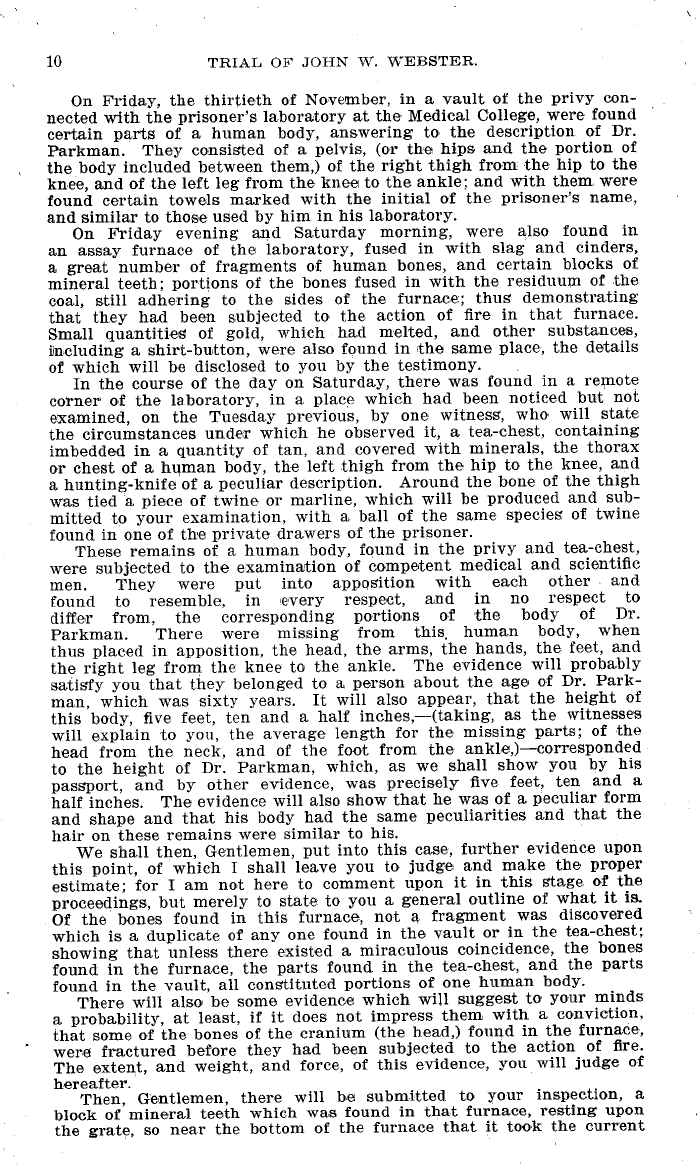|
10 TRIAL OF JOHN W. W EBSTER.
On Friday, the thirtieth of November, in a vault of the privy con-
nected with the prisoner's laboratory at the Medical College, were found
certain parts of a human body, answering to the description of Dr.
Parkman. They consisted of a pelvis, (or the hips and the portion of
the body included between them,) of the right thigh from the hip to the
knee, and of the left leg from the kneel to the ankle; and with them were
found certain towels marked with the initial of the pr'isoner's name,
and similar to those used by him in his laboratory.
On Friday evening and Saturday morning, were also found in
an assay furnace of the laboratory, fused in with slag and cinders,
a great number of fragments of human bones, and certain blocks of
mineral teeth; portions of the bones fused in with the residuum of .the
coal, still adhering to the sides of the furnace.; thus demonstrating
that they had been subjected to the action of fire in that furnace.
Small quantities of gold, which had melted, and other substances,
including a shirt-button, were also found in the same place, the details
of which will be disclosed to you by the testimony.
In the course of the day on Saturday, there was found in a remote
corner of the laboratory, in a place which had been noticed but not
examined, on the Tuesday previous, by one witness, who will state
the circumstances under which he observed it, a tea-chest, containing
imbedded in a quantity of tan, and covered with minerals, the thorax
or chest of a human body, the left thigh from the hip to the knee, and
a hunting-knife of a peculiar description. Around the bone of the thigh
was tied a piece of twine or marline, which will be produced and sub-
mitted to your examination, with a ball of the same species of twine
found in one of the private drawers of the prisoner.
These remains of a human body, found in the privy and tea-chest,
were subjected to the examination of competent medical and scientific
men. They were put into apposition with each other and
found to resemble, in every respect, and in no respect to
differ from, the corresponding portions of the body of Dr.
Parkman. There were missing from this human body, when
thus placed in apposition, the head, the arms, the hands, the feet, and
the right leg from the knee to the ankle. The evidence will probably
satisfy you that they belonged to a person about the age of Dr. Park-
man, which was sixty years. It will also appear, that the height of
this body, five feet, ten and a half inches,-(taking, as the witnesses
will explain to you, the average length for the missing parts; of the
head from the neck, and of the foot from the- ankle,)-corresponded
to the height of Dr. Parkman, which, as we shall show you by his
passport, and by other evidence, was precisely five feet, ten and a
half inches. The evidence will also show that he was of a peculiar form
and shape and that his body had the same peculiarities and that the
hair on these remains were similar to his.
We shall then, Gentlemen, put into this case, further evidence upon
this point, of which I shall leave you to judge and make the proper
estimate; for I am not here to comment upon it in this stage of the
proceedings, but merely to state to you a general outline of what it is.
Of the bones found in this furnace, not a fragment was discovered
which is a duplicate of any one found in the vault or in the tea-chest;
showing that unless there existed a miraculous coincidence, the bones
found in the furnace, the parts found in the tea-chest, and the parts
found in the vault, all constituted portions of one human body.
There will also be some evidence which will suggest to your minds
a probability, at least, if it does not impress them with a conviction,
that some of the bones of the cranium (the head,) found in the furnace,
were fractured before they had been subjected to the action of fire.
The extent, and weight, and force, of this evidence, you will judge of
hereafter.
Then, Gentlemen, there will be submitted to your inspection, a
block of mineral teeth which was found in that furnace, resting upon
the grate, so near the bottom of the furnace that it took the current
|

